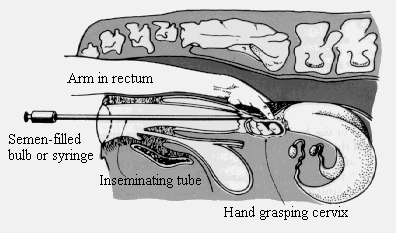|
Artificial Insemination
|
|
|
(Picture courtesy of University of Alberta ) |
|
|
Artificial insemination (AI) is a breeding method where sperm is placed into the female's cervix (intracervical), uterus (intrauterine), ovarian follicle (intrafollicular), or fallopian tubes (intratubal) using an artificial method rather than leaving breeding up to the animals themselves. First, semen is collected from the bulls. An extender solution, which dilutes the semen, is added to the sample to increase the ability of a few sperm to impregnate one female by increasing the viability of the sperm. The extender solution contains antibiotics, cyroprotectants, milk or egg yolk, a buffer, and glucose. The antibiotics prevent contamination. The milk or egg yolk helps stabilize the sperm as they experience cold shock from being outside the body. The buffer, usually citrate, helps maintain a natural pH so the cells do not get denatured. Glucose is an energy source for the sperm. The cyroprotectant, usually glycerol, protects the sample when it gets preserved through cooling or freezing in liquid nitrogen. The samples are kept in small plastic tubes called "straws" which contain about 20 million spermatozoa each. The Purpose AI was first implemented by the dairy industry in the 1930's to improve production traits in the herd and as a means to get away from having to handle the aggressive bulls. Desirable dairy traits to select for include: feed efficiency, high milk production, and calving ease. Since the semen can be shipped worldwide, this increases the genetic pool which a dairy farmer has access to in his breeding program. About 75% of the dairy industry uses artificial insemination because it swiftly allows them to improve production in their herd in a cost effective manner. Another advantage is that it reduces the spread of disease from animal contact. AI Use at Cal Poly The Cal Poly Dairy Unit uses artificial insemination in their breeding program. The three main sites used for the breeding program are the bull barn, the semen laboratory, and the physiology laboratory. In 2005 there were about 25 bulls at the unit.
|

